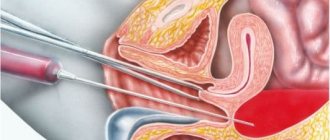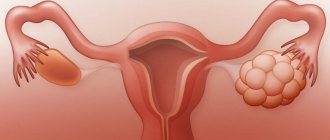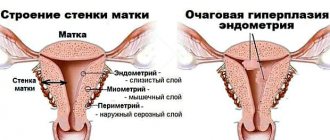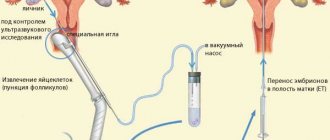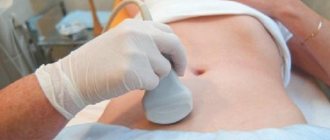Puncture is the process of piercing an organ, vessel or some formation for therapeutic and/or diagnostic purposes. In most cases, the procedure is performed under short-term general intravenous anesthesia and takes no more than 30-40 minutes, often even less. Puncture of an ovarian cyst allows you to clarify the nature of the disease, with a high probability of excluding an oncological process, and sometimes it helps to immediately get rid of the tumor. When and to whom is manipulation prescribed? How is the process carried out and are there any complications?
What's happened
Puncture is a procedure that can be used for both diagnostic and therapeutic purposes. The main task of such an intervention is to obtain the contents with which the cystic cavity is filled.
This manipulation is used to clarify the type of pathological process when the use of other methods is not possible.
The puncturing procedure can also be prescribed in the treatment of certain types of ovarian tumors.
On this topic
- Female reproductive system
Differences between cytology and colposcopy
- Natalya Gennadievna Butsyk
- December 6, 2021
Puncture is a minimally invasive method, is of high value in diagnosis, makes it possible to make an accurate diagnosis and choose the most appropriate tactics for therapeutic measures.
Puncture is done in a hospital setting. Before the operation, certain preparatory measures are required.
This type of surgical intervention rarely causes complications, but for this it is necessary to strictly follow all the specialist’s instructions.
Most women tolerate the procedure well. The recovery period does not take much time.
Indications
Puncture of an ovarian cyst is a simple operation, but it can only be performed by a highly qualified specialist and only under ultrasound control.
The procedure is often performed in order to clarify the presence of pathology and make a correct diagnosis. In addition, if there is tumor growth, it is used as a therapeutic method. Treatment in this case will consist of extracting the contents of the cystic tumor.
Doctors also prescribe manipulation if the growth of a tumor has been detected, the size of which exceeds two centimeters in diameter.
In general, no precise indications for surgery have been identified. The decision to perform puncture is made solely by the attending physician.
Advantages of puncture over excisional biopsy
Before answering the main question, every patient should know that with the excision method of examination, the surgeon removes a certain area of tissue. Therefore, puncture has a number of significant advantages compared to this method.
- The patient does not need to visit the surgeon before the procedure. Therefore, the time for diagnosis is significantly reduced.
- A biopsy is usually performed if the patient has a benign process in the mammary gland. If in this case an excisional biopsy is used, this can lead to deformation of the gland.
- After the excision procedure, large scars remain.
- Material obtained surgically takes longer to study.
As you can see, there are many benefits of puncture. But, in addition, it should be noted that the cost of puncture is several times less compared to the excisional procedure.
Contraindications
Despite the fact that puncture of an ovarian cyst is a safe procedure, there are a number of limitations when its use is contraindicated.
Thus, the puncture cannot be done immediately before the onset of the menstrual cycle. Also limited is the period of gestation, the presence of malignant neoplasms, the development of diseases of an infectious nature, inflammation of the peritoneal cavity, allergic reactions to certain components present in the composition of drugs used during or after surgery.
In addition, such manipulation for diagnostic or therapeutic purposes is prohibited if the normal process of blood fluid clotting is disrupted.
Experts also do not recommend this procedure during menopause. This is explained by the fact that this condition can provoke the re-development of a cystic neoplasm.
Before deciding that a puncture is a necessary measure, the specialist must also take into account indicators such as the location of the cyst, the size of the tumor, the age and condition of the patient. Only on the basis of these data, after weighing all the pros and cons, is surgical intervention prescribed.
Complications of ovarian cysts
Despite their benign origin, ovarian cysts that are not diagnosed and treated in time can have serious consequences requiring surgical intervention.
- An advanced cyst may require removal along with the ovary.
- The rupture of a follicular cyst leads to the release of its contents into the abdominal cavity, which can cause inflammation in the body.
- Torsion of an ovarian cyst is a serious complication of the disease. In this case, symptoms of “acute abdomen” occur (severe pain, nausea, vomiting). Blood circulation in the cyst is disrupted and necrosis develops, resulting in inflammation in the abdominal cavity.
- Twisting of the cyst stalk through a loop of intestine causes intestinal obstruction.
- An unfavorable consequence of an advanced ovarian cyst is infertility. After one ovary is removed, a woman continues to produce eggs from the other. However, if both ovaries are damaged or serious hormonal imbalances occur, ovulation will not occur, and, accordingly, conception is impossible. In this case, they resort to the procedure of in vitro fertilization. If it is not possible to collect eggs from a woman, then eggs from a donor are used.
In Volgograd, you can carry out the IVF procedure at the IVF Center clinic, whose specialists have extensive experience in treating infertility. The clinic carries out IVF protocols, including those using donor genetic material.
Preparation
To determine all available indications and contraindications for the procedure, as well as to identify possible factors that provoked the formation of a cystic tumor in the ovary, the doctor refers the woman to undergo a diagnostic examination. Without laboratory and instrumental research data, it is strictly prohibited to perform a puncture.
Diagnostic methods include:
- general analysis of urine and blood fluid;
- coagulogram - a study that allows you to determine blood clotting;
- ultrasonography ;
- computed and magnetic resonance imaging;
- tests to determine the malignancy of the pathological process;
- blood test to detect syphilis, HIV infection or hepatitis;
- electrocardiogram.
The choice of diagnostic measures for each patient occurs individually. In some situations, culdocentesis for ovarian cysts is also added to the general diagnostic methods. It consists in the fact that puncture is carried out through the posterior vaginal fornix.
The main objective of this technique is to identify the presence of excess fluid in the pouch of Douglas. It is at the location of the uterus and rectum that the contents of the tumor are released when it ruptures. If there is fluid in this cavity, the doctor removes it and sends it for further research.
In addition to the fact that a number of diagnostic measures are carried out before puncture of the cyst, women also need to follow some rules during the preparation period. So, at least four days in advance it is necessary to exclude intimate intimacy.
On this topic
- Female reproductive system
Echosigns of adenomyosis
- Olga Vladimirovna Khazova
- December 4, 2021
It is also important to adhere to proper nutrition. The diet should include foods enriched with fiber in large quantities. It is advisable to exclude the consumption of exotic fruits and citrus fruits, alcohol and carbonated drinks during this time.
If surgery is performed in the morning, then it is advisable not to eat in the evening. Breakfast is also prohibited on the day of the operation.
How to do it
The puncturing technique involves performing certain sequential steps.
The entire surgical process is carried out only under the control of an ultrasound machine. The cyst is searched using a special sensor, through which the image is displayed on the monitor.
Next, using ultrasound control, the cyst is also punctured. A needle is inserted into the tumor cavity and a syringe is attached to it.
When the syringe plunger is pulled back, the contents of the tumor are removed. The specialist sends the resulting pathological material to the laboratory for further study. After the fluid has been removed, the needle is removed.
If the puncture is used for therapeutic purposes, then an alcohol solution is injected into the cystic cavity. The tumor walls stick together and the pathological process regresses.
Currently, puncture is used to remove a cyst in extremely rare cases. When a neoplasm of a functional type is formed. In most situations, spontaneous regression occurs, which does not require surgical intervention.
If the cyst does not have a predisposition to self-resorption, for example, a paraovarian or dermoid tumor is diagnosed, then puncture will be useless. The ineffectiveness of such intervention is also noted with true neoplasms affecting the ovaries.
Particular attention must be paid to puncture when the cyst is accompanied by ovarian endometriosis. Some clinics practice such manipulations, which involve the use of medications. The effectiveness of the operation will be observed in 80 percent of cases.
After all operational measures have been carried out, the woman is transferred to the general ward, where she remains for at least a day. During this time, the patient should be constantly monitored.
In the first few hours, a nagging soreness may be noted in the lower abdomen, which goes away on its own. If the patient’s well-being returns to normal and does not worsen, then she is discharged on the third day.
Possible problems
Each organism has its own individual characteristics, and therefore its reaction to puncture may be different.
Most often, the woman tolerates the procedure well, and performance returns quickly..
However, some patients may experience side effects such as headache, general weakness, pain and discomfort in the abdomen, bloating, increased tone of the peritoneal muscles, and slight vaginal discharge with blood.
Such a reaction, in principle, is assessed as natural and does not require special measures.
It is necessary to sound the alarm if these symptoms persist for a long time, as well as when such signs appear:
- severe dizziness, sometimes to the point of unconsciousness;
- nausea and vomiting;
- rise in body temperature above 37.5 degrees;
- vaginal discharge with intense bloody impurities;
- intense pain in the form of attacks in the abdomen or lower back;
- noticeable pallor of the skin.
These symptoms may indicate serious postoperative complications, which include:
- ovarian hyperstimulation;
- inflammatory process in the appendages;
- internal bleeding at the needle insertion site.
IMPORTANT!
It should be noted that these consequences are not necessarily caused by incorrect actions of the doctor. This is how the body itself can react.
In any case, if alarming signs appear, you should immediately consult a doctor to find out the reasons for their appearance.
